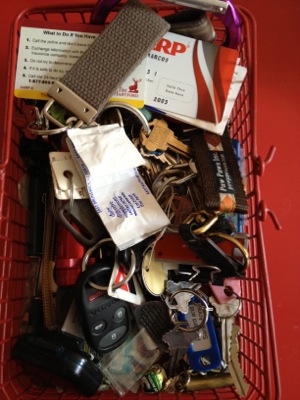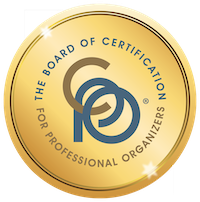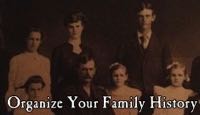Decluttering my keys
I’m a big believer in having one place where the keys are placed when coming in the door. In our house, it’s been a coated-wire basket just inside the back door, where we enter from the garage. We now automatically drop our keys right in the basket.
The trouble was every key we owned was in that basket, so in order to find the keys I needed on a daily basis, I was having to do a little searching. After a few months of telling myself I needed to do something about it, I finally did.
I thought maybe key hooks would be a good idea for our most frequently used keys, but my husband really likes the ease of just dropping the keys in a container. And who am I to argue with ease?
So here’s how it went, step by step. I was a little surprised that it ended up taking two full hours, but it was time well spent.
Here’s how the key basket looked at the beginning of the two hours:

Step One: Empty the container and sort
I emptied the basket and sorting the keys by category. (I discovered lots of non-key items in the key basket as well.) Here’s a photo of the contents of that basket, spread out on my kitchen counter:

There were five categories of keys:
- House keys (a full set for each of us)
- House keys (a subset, for dog walking)
- Car keys (two cars, each with two keys)
- Keys to friends’ homes
- Keys to a work locations
- Untagged mystery keys
Step Two: Solve some mysteries
I took the mystery keys and tried them on our doors. We have a two-family house, but we live in the whole thing. That means we have two front doors and two back doors. And one of our front doors has two locks, though we only use one of them.
In that process, I was able to identify seven previously unidentified keys to our house:

Step Three: Label the keys
I got out my label maker and created labels for all the keys to our friends’ homes and work locations and for the newly identified keys. I didn’t bother to label the keys that are on our daily key rings; we know them by sight.

Step Four: Organize the keys in a new container
Barry and I agreed that the wire basket wasn’t great because keys would sometimes get caught in the holes. So I replaced it with a clear plastic drawer organizer I had on hand. Since one of the problems had been that it was hard to find the keys we needed among the many keys in the basket, I decided to place only the first three categories of keys in this new container. (Main key rings, dog-walkings, car keys.)
I put the labeled friends’ keys on a carabiner and the extra keys for our doors on a binder ring. I placed those two bundles in a basket that sits on the shelf next to the key basket. (That basket also holds eye glasses and cases.)

Step Five: Organize a few non-key items in the container
There were a few items in the old key basket that we like to have close at hand when we’re walking out the door. They include lip balm, lactase enzyme tablets and a little magnifier/flashlight that makes menu reading easier, and a small flashlight for nighttime dog walking. So I took a smaller drawer organizer and put into the larger one to isolate most of those items, so they’re not in the way.

Overall, I’m really pleased with how this worked out. It’s not perfectly organized by any stretch of the imagination. But it is organized enough: The keys we need most often are easier to grab and it will be as easy as ever to put them away. Now we can easily identify our friends’ keys when we need them. And if we need an extra set of our own to give someone, they’ll be easy to find.
(I bet you’re wondering what we did with the keys we couldn’t identify. The organizer in me wanted to get rid of them, but my husband was more comfortable keeping them. I put them in a zip-top bag marked “These keys are not for our house” and put them in a drawer in our extra kitchen where I would know to look for them if we were ever looking for keys that someone said they had given us.)
Gretchen Rubin on self-knowledge
I’ve long been a fan of Gretchen Rubin and her Happiness Project.
She was one of the fantastic speakers at the World Domination Summit I attended in July. Her topic was self-knowledge and how being aware of who you are makes happiness much easier to achieve. It was fascinating and enjoyable.
The talk was full of nuggets like these:
- When we acknowledge the truth of who we are, we must also acknowledge who we are not and who we will never be.
- What you envy is really revealing.
- We should always pay special attention to anything we try to hide (in other words, pay attention to what we lie about).
- What you enjoy doing as an adult is usually related to what you did for fun when you were ten years old.
- People are either abstainers or moderators — and once you know your own nature, it’s much better to organize things to suit yourself (this is fascinating stuff!)
- Gretchen has identified four categories of people that reflect the tendencies people have when it comes to habits:
- Upholders, who respond to outer and inner expectations alike
- Questioners, who question all expectations (outer and inner)
- Rebels, who resist all expectations (outer and inner)
- Obligers, who meet outer expectations but have trouble exposing inner expectations on themselves
In the talk, Gretchen explained the implications of being in each category. (I’m an Upholder, btw.)
You can learn more from Gretchen Rubin by reading her books, The Happiness Project and Happier at Home or reading her blog, The Happiness Project.
Or you can just spend 40 minutes watching the video of her World Domination Summit talk. Trust me, it’s 40 minutes well spent.
Gretchen Rubin from Chris Guillebeau on Vimeo.
Gretchen’s next book is on habits. I can’t wait to read it!
Worth repeating: Working with an organizing team
I wrote this blog post in February 2012, and it’s more true now than ever. I’ve renamed my team organizing OPERATION: PEACE OF MIND and these days I’m doing more team organizing than one-on-one organizing. The results are amazing!
When I started my organizing business in 2005, I exclusively worked one-on-one with clients. It’s intimate, fulfilling, valuable work. But it can be really slow. And that means progress is harder to see and it can become discouraging for the client.
A few years ago, I started to be approached by clients who had very large, whole-house decluttering jobs. I realized that bringing in more help was in order. And so every now and then I would put together an organizing team to effect quick change on giant projects.
In the last year or so I realized that it wasn’t just huge or overwhelming projects that could benefit from a team approach. As the long as the client can handle the hubbub and the faster pace of a team, there are many benefits, not the least of which is the visible results we see after a single session.
I don’t have employees. When I put together an organizing team, I use independent contractors, members of the St. Louis chapter of the National Association of Professional Organizers. I call on organizers I know personally, thanks to NAPO St. Louis. I’m always on site supervising them and coordinating the efforts. I’m also typically the one working with the clients to guide decisions.
Here are some of the advantages I have found to team organizing:
- We get a whole lot done. If I’m working one-on-one with a client, I not only guide the decisions, but implement them. When I’m working with a team, there’s someone to do the leg work and everything happens a whole lot faster. Also, the team members pre-sort items for the client before the keep/donate/toss decisions are made (in a decluttering situation), which makes the decision-making much easier. As a result, the client sees visible progress, which isn’t always the case after a one-on-one session.
- It’s economical. I charge less for the time of organizing team members than I charge for my own time. So bringing in a team is not only faster than working with me one-on-one, it’s less expensive.
- More minds are better than one. I populate my teams with smart and talented organizers. I’d be crazy not to tap into their considerable skills and knowledge on the job. While I’m working with the client, I frequently consult team members on the best way to approach or organize a space. So the client benefits from the cumulative knowledge of the group.
- It’s fun! All the organizers I use love working on teams. Doing work we love (sorting and organizing) alongside our colleagues practically makes us giddy. And that’s contagious. While it’s tiring for the client to make a lot of decisions in a short period of time, most confess to having fun while doing it during our team jobs. Time flies.
Here’s a before and after combo from a team job at the end of 2010. Two of the organizing team members worked in this kitchen while the client worked with me and other team members in another part of the house. The client gave basic parameters and was brought in to answer questions periodically. She was thrilled at the end of the day.

A cluttered kitchen before a team arrived to help.

Two organizers created this transformation as part of a team project.
This year, my goal is to help more clients this way. I’m hooked on the fun of the team approach and the quick results. If you have a big project that seems overwhelming, maybe I could bring in an organizing team to help you. Take a look at my Team Organizing page to read a few more details. Then feel free to give me a call or shoot me an email to discuss how a team might help you!
Do you have a bucket list?
You know what a bucket list is, right? It’s a list of things you want to do before you die.
I’m very goal-oriented, but I have to admit I’ve never taken the time to create a bucket list. Today, I read an article on Fast Company’s website called How Creating a Better Bucket List Becomes a Blueprint for Living Your Best Life-. It made me want to take some time out and really think about such a list.
I think my favorite part of the article might have been item number three: Improve your daily life. I love the idea of a bucket list not being all about single events, but rather about achieving goals that enhance your life.
I have a retreat coming up next month; if I don’t do it before then, I think I’ll take some time to create a really mindful bucket list.
I’m also a big believer in item number four: Build in accountability. Perhaps after I create this list, I’ll share it here!
If you haven’t created a bucket list, you might want to check out this article!
Worth repeating: Closet issues
If you have trouble parting with clothes, you’re not alone. Even Oprah Winfrey has a tough time, as I explained in this 2010 blog post. Incidentally, I still adore the fact that the clothes in my closet are organized by color!
Cleaning out the clothes closet is difficult for many people. Clothes can represent so much — like music, they can do a great job of capturing a feeling about an occasion or part of life. They also can represent hopes. You hope to wear that size again. Or you hope to have an occasion to wear that evening gown.
The trouble with hanging on to clothes that you don’t or can’t wear is that an overcrowded closet makes it so difficult to care for the clothes you do wear. It’s hard to put clothes away if they’re packed in too tight. They also get wrinkled. And it’s much harder to see what you have.
I was just perusing the March 2010 issue of O Magazine, whose theme is “De-Clutter Your Life!” In one of the articles, Oprah Winfrey goes through her closet trying to decide what to keep and what to let go of, with the help of the magazine’s creative director, Adam Glassman. What struck me about the article was that even Oprah, who has an almost unimaginable about of money, had difficult letting go of stuff. At one point in her life she had a very limited wardrobe because of budget. “Even now, wasting money on clothes makes me crazy,” she admits in the article.
After insisting on saving some beautiful items (she calls a pair of boots she’s never worn “closet jewelry”), Oprah agrees to let go of trendy items she doesn’t wear. It appears that Adam’s suggestion that the discarded clothing be auctioned off on Ebay to raise funds for OWLA, Oprah’s leadership academy for South African girls, makes it easier for her to let go.
I see this in my clients; if they know the article of clothing will be loved by someone else, they’re more able to let it go. They’d like to give stuff to me, but my policy is not to accept items that my clients are letting go of. (It prevents the appearance of conflict of interest and helps keep my home clutter-free.)
So next time you’re trying to weed out your closet, remember that Oprah found it difficult. You can imagine how beautiful the clothes she was discarding were, but she did it.
As an aside, my friend, the organizer extraordinaire Geralin Thomas helped me weed and organize my closet on a visit in 2009. She convinced me to arrange my clothes by color, something I resisted. I felt it was hyper-organized and would be too complicated for me. Boy, was I wrong. I love having my clothes sorted by color. (I organize them by category first, then by color. All blouses are together, in color order, all jackets, pants, etc.) Not only is it beautiful, but it makes it very easy to find what I need and to put individual items away.
And the less densely populated the rods, the more I enjoy my color-coded closet.
Friday Fun: Ella Mae sings along to Elvis
I originally saw this video on Facebook and have watched all five minutes and forty seconds of the video at least a half dozen times. It makes me smile and laugh each time. In case you have seen it, I thought I’d share it here so you can smile and laugh with Ella Mae too.
Little Ella, who according to ABC News is 21 months old, clearly loves her Elvis and her daddy. Be sure and watch it through to the soulful finale!
Worth repeating: Standards of clutter
I wrote this blog post four years ago and it remains relevant. Clutter is truly in the eye of the beholder, which can become a problem when people in the same household have different standards!
Since I specialize in working with chronically disorganized people, I’ve seen a lot of clutter. I’ve worked in homes so full of stuff they were uninhabitable (literally).
But I’ve also been hired to do consultations for people for whom there was no visible clutter, at least at first glance. Yet those folks made the effort to schedule an appointment and paid me to advise them on how to deal with stuff that was bothering them. To my eye, it was small, easily addressable stuff. But to them it was a problem. (I always have to remind myself never to trivialize someone’s problem.)
It just goes to show you that clutter is in the eye of a beholder. I’m fond of saying that clutter isn’t a problem unless it’s a problem. Some people like having a little clutter around. Personally, I feel a little itchy when I walk into homes where literally everything’s in place. To me, that’s sterile, not comfortable. But if I were someone who desired such a home, then a pile of papers on the desk that won’t go away is clutter. Heck, a single sheet of paper that didn’t have a home would feel like clutter.
If you live alone, then your standard of clutter is your business. If you’re functioning well and the clutter doesn’t bother you, then it’s not a problem. (I define being cluttered as having more stuff than will fit in the storage spaces available.)
When you live with others, particularly with people with differing standards of clutter, it gets difficult. And that’s when compromise has to come into play. Sometimes the solution is to have private spaces within a home that don’t get messed with. So a neat person can have a pristine space without it being cluttered up by the spouse. And a messy person can mess up a room all he or she wants without being nagged about it.
My own standards of clutter are fairly relaxed. Compared to some of my chronically disorganized clients, my home is quite pristine. But I don’t mind if a few things don’t get put away, when it’s just my husband and me at home. When I’m expecting guests, however, I up the ante. Back in August I hosted a social event for members of the St. Louis chapter of the National Association of Professional Organizers. In anticipating that event, I had a little melt down as I worried how the other organizers might judge me for my less-than-perfect home. (I was being irrational, since of course I know that these great POs are not judgmental…but my being the president of the chapter made me feel like perhaps my standards should be higher.) Right after that event, I blogged about the experience at the fabulous website, Unclutterer.
In your own organizing journey, if you can get your home to the point where your own standard of clutter is met, and then create routines so that you keep your house at that comfortable level, then you’re a success, in my opinion. It doesn’t matter if that standard is different from what your mother (or mother-in-law) might approve of. As long as everyone in your home is comfortable and you’re functioning well, then you’re in good shape. Try not to impose other people’s standards of clutter on your home.
Links
- NAPO St. Louis
- National Association of Productivity and Organizing Professionals
- Ravelry
- Organize Your Family History
- Institute for Challenging Disorganization
- Getting to Good Enough podcast
- Shannon Wilkinson, life coach
- Peace of Mind Spending
- Are you interested in becoming a professional organizer?








